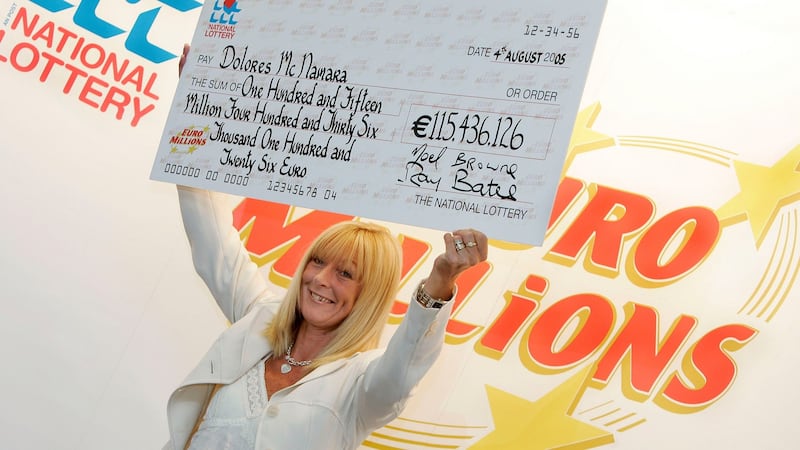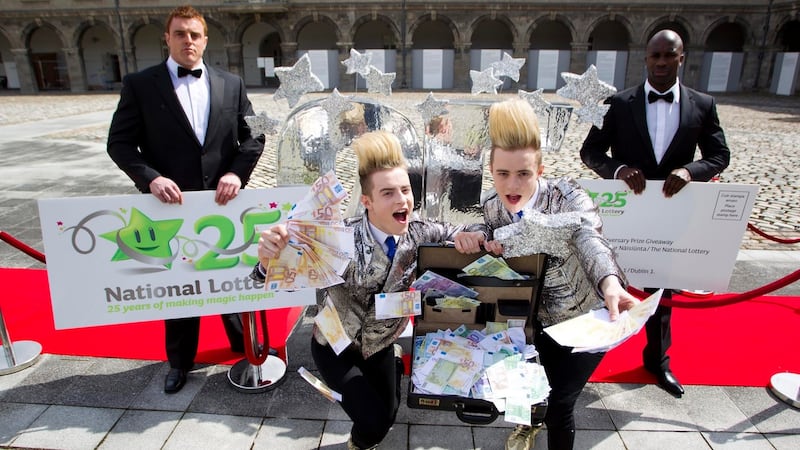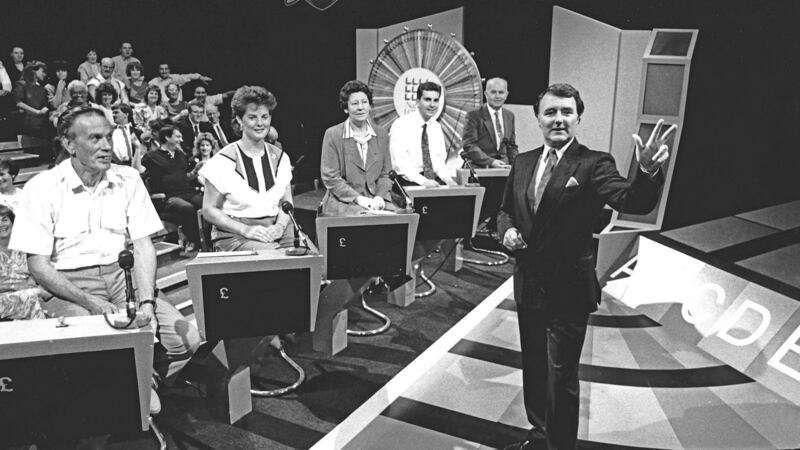On the first floor of an office block on Abbey Street in central Dublin, there’s a special room with cream-coloured walls, white furniture, expensive subdued lighting and freshly cut flowers.
A fridge tucked discreetly in the corner is permanently stocked with champagne. On a sticky July day, the air-conditioning is keeping things pleasantly cool and calm.
It could be the first-class lounge of a modern airport, were it not for the brochures spread out on the polished table, bearing the words: “When your dreams come true . . . Hints and tips for winners.”
0 of 3

Should you ever win a major prize in the National Lottery, which is throwing a party next week to celebrate its 30th anniversary, this is where you'll find yourself when you show up with your ticket.
If you go there because you have won more than a million, you will be joining a surprisingly large club of more than 800 people who have become millionaires since the lottery launched in 1987.
"One thing that distinguishes us from the UK lottery is they tend to get their winners coming in first thing on the Monday morning, whereas Irish winners tend to be more relaxed," says chief executive Dermot Griffin.
“They’ll normally ring and make an arrangement to come in, or they’ll even wait a few days before ringing. But we’ve also had situations where they’re waiting at the door first thing in the morning after being at an early bar.”
Next Wednesday, Taoiseach Leo Varadkar will attend a special edition of the televised mid-week Lotto draw to celebrate the 30th birthday of the National Lottery.
There’s a bit of jiggery-pokery going on with the actual dates – Lottery scratchcards were launched in March 1987 with the full Lotto draw following a year later.
But there is no doubt that over those 30 something years the Lottery has become such a familiar fixture in the daily pattern of Irish life that it’s a milestone worth marking.
Controversies
It hasn't been without its controversies. "Let the Games Commence," read the caption under the main picture on the front page of The Irish Times on March 23rd, 1987, which featured a suitably imperious-looking Charles Haughey releasing hundreds of balloons at the Royal Hospital, Kilmainham to mark the first week of operations. That launch followed the passing by the preceding government of the National Lottery Act, 1986 to help raise funds for "good causes".
Derided in some quarters as “a tax on stupidity” because the odds against winning are so high, and criticised as providing a slush fund for successive government politicians to sweeten their own constituencies, the lottery has, to be fair, more than achieved the objectives set out in the original establishing legislation.
More than €4.9 billion has been raised and spent on projects in the designated areas of health, sport, arts, heritage, welfare and the environment. Last year, 895 local sports projects received over €45 million. Arts projects were awarded more than €78 million in funding and €2 million went towards Irish language support schemes. Over €7 million in lottery funding was awarded by the HSE and the Department of Health.
Of every euro spent by players, 52 cent comes back in prizes, 30 cent goes to funding the nominated good causes and six cent goes to retailers, with the remainder going to the operator and running costs.
Dramatic wins
The most dramatic storyline of the early years was the attempt by a 28-member Dublin syndicate to beat the system by buying a ticket for every possible permutation of numbers, on the basis that this could be done for less than a million pounds. The syndicate put its plan into action in May 1992 when the jackpot reached £1.7 million. Although the lottery managed to prevent them buying all the numbers by limiting the number of tickets that could be sold at each terminal, they did manage to purchase over 80 per cent of the combinations, spending an estimated £820,000 in the process and winning total prize money of £1,166,000.

To prevent further attacks, the National Lottery quickly changed Lotto to a 6/39 game, raising the jackpot odds to one in 3,262,623. In compensation for the longer odds, the starting jackpot was doubled and a “bonus number” was added.
In 1994, it increased the numbers again, with bigger rollover jackpots to compete with the new UK lottery. In the same year, computer-generated “quick picks” were introduced. Since then, the biggest change has been the introduction of the Euromillions draw, with its huge jackpots.
Despite these developments, the basic model has changed remarkably little over the past three decades. There was no internet in 1987, of course, while mobile phones were as big as briefcases and cost thousands of punts. Now, the lottery co-exists alongside a plethora of online gambling services. Its own IOS and Android apps have been downloaded more than 700,000 times and it has 380,000 registered online players. However, 90 per cent of revenue still comes through the traditional network of 5,000 retailers.

Bookmakers have been taking bets on lottery numbers for years, but a new breed of online gambling sites, often based in Gibraltar, are looking to compete more aggressively. "They take a bet on the lottery numbers, but obviously there's no money going to good causes," says Griffin, who succeeded Ray Bates as chief executive in 2005.
Technology
When the 20-year licence to operate the lottery was won by Premier Lotteries, Griffin and other key staff moved over from the previous company operated by An Post. That new licence required a switch to a new technology platform. Most of the terminals are now connected through the 3G mobile network – a roaming SIM card provided by Spanish telco Telefonica allows them to pick up the strongest signal at any given time in their area, and to automatically switch network if there's any problem. In theory, it's a robust system – until it fails, which it did in February 2015, when Telefonica had a major systems failure, causing the unprecedented cancellation of a draw. Since then, though, everything has run pretty smoothly.
Large screens in the technology department monitor connectivity, traffic and transactions across the network. Updates and information can also be pushed out to video screens in shops around the country. While the current legislation states that, online or in shops, the lottery can be played only between 7am and 10pm, the company is now seeking to start an hour earlier to reflect changing commuter patterns.
Dealing with winners
Claims manager Gerry O’Donoghue and claims executive Ronan Cooney have years of experience dealing with winners. If it’s a big jackpot, the claims team will suggest the winner consider getting legal or financial advice on how to handle it. Their first contact is usually over the phone, when people ring in to confirm their numbers are correct. “Usually people are very anxious when they ring in because they have this very valuable piece of paper,” says O’Donoghue. “We have to slow them down and calm them down a bit.”

Cooney says that people may appear calm, “but when you confirm the numbers you can hear them screaming in the background”.
They’ve seen some remarkable coincidences. A few times winners have accidentally doubled their money because two members of the same family unwittingly went into separate shops to play their usual weekly numbers. On one occasion two different families from two different parts of the country came in one day with winning numbers based on the life story of Padre Pio. “The same people, totally unknown to each other, had picked those numbers for the same reason and shared the prize,” says O’Donoghue.
There will be a special extended broadcast of the mid-week Lotto draw to mark the anniversary in front of a live audience including Taoiseach Leo Varadkar on RTÉ One at 7.55 pm on Wednesday, August 2nd.
Memorable winners
In 1989 Rita Power from Co Galway became Ireland’s first Lotto millionaire.
In 2005, Dolores McNamara became the biggest ever jackpot winner, when she won over €115 million in the EuroMillions jackpot.
The Dan Morrissey Syndicate of 15 work colleagues from Co Carlow won the largest Lotto jackpot prize of €18.9 million in 2008.
In 2015, more than 1.4 million players played National Lottery games on a regular basis, representing over 42 per cent of the adult population.










